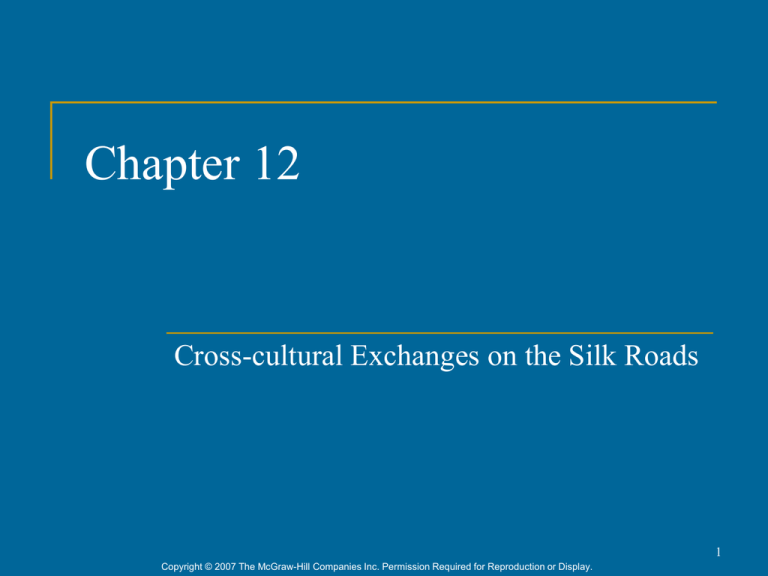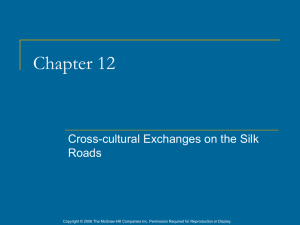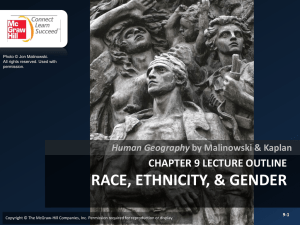12. Cross-Cultural Exchanges on the Silk Roads
advertisement

Chapter 12 Cross-cultural Exchanges on the Silk Roads 1 Copyright © 2007 The McGraw-Hill Companies Inc. Permission Required for Reproduction or Display. Long-Distance Travel in the Ancient World Lack of police enforcement outside of established settlements Changed in classical period Improvement of infrastructure Development of empires 2 Copyright © 2007 The McGraw-Hill Companies Inc. Permission Required for Reproduction or Display. Trade Networks Develop Dramatic increase in trade due to Greek colonization Maintenance of roads, bridges Discovery of Monsoon wind patterns Increased tariff revenues used to maintain open routes 3 Copyright © 2007 The McGraw-Hill Companies Inc. Permission Required for Reproduction or Display. Trade in the Hellenistic World Bactria/India Persia, Egypt Grain Mediterranean Spices, pepper, cosmetics, gems, pearls Wine, oil, jewelry, art Development of professional merchant class 4 Copyright © 2007 The McGraw-Hill Companies Inc. Permission Required for Reproduction or Display. The Silk Roads Named for principal commodity from China Dependent on imperial stability Overland trade routes from China to Roman Empire Sea Lanes and Maritime trade as well 5 Copyright © 2007 The McGraw-Hill Companies Inc. Permission Required for Reproduction or Display. The Silk Roads 200 BCE – 30 CE 6 Copyright © 2007 The McGraw-Hill Companies Inc. Permission Required for Reproduction or Display. Organization of Long-Distance Trade Divided into small segments Tariffs and tolls finance local supervision Tax income incentives to maintain safety, maintenance of passage 7 Copyright © 2007 The McGraw-Hill Companies Inc. Permission Required for Reproduction or Display. Cultural Trade: Buddhism and Hinduism Merchants carry religious ideas along silk routes India through central Asia to east Asia Cosmopolitan centers promote development of monasteries to shelter traveling merchants Buddhism becomes dominant faith of silk roads, 200 BCE-700 CE 8 Copyright © 2007 The McGraw-Hill Companies Inc. Permission Required for Reproduction or Display. The spread of Buddhism, Hinduism, and Christianity, 200 BCE – 400 CE 9 Copyright © 2007 The McGraw-Hill Companies Inc. Permission Required for Reproduction or Display. Buddhism in China Originally, Buddhism restricted to foreign merchant populations Gradual spread to larger population beginning 5th c. CE 10 Copyright © 2007 The McGraw-Hill Companies Inc. Permission Required for Reproduction or Display. Buddhism and Hinduism in SE Asia Sea lanes in Indian Ocean 1st c. CE clear Indian influence in SE Asia Rulers called “rajas” Sanskrit used for written communication Buddhism, Hinduism increasingly popular faiths 11 Copyright © 2007 The McGraw-Hill Companies Inc. Permission Required for Reproduction or Display. Christianity in Mediterranean Basin Gregory the Wonderworker, central Anatolia 3rd c. CE Christianity spreads through Middle East, North Africa, Europe Sizeable communities as far east as India Judaism, Zoroastrianism also practiced 12 Copyright © 2007 The McGraw-Hill Companies Inc. Permission Required for Reproduction or Display. Christianity in SW Asia Influence of ascetic practices from India Desert-dwelling hermits, monastic societies After 5th c. CE, followed Nestorius Emphasized human nature of Jesus 13 Copyright © 2007 The McGraw-Hill Companies Inc. Permission Required for Reproduction or Display. Spread of Manichaeism Mani a devout Zoroastrian (216-272 CE) Viewed himself a prophet for all humanity Influenced by Christianity and Buddhism Dualist good vs. evil light vs. dark spirit vs. matter 14 Copyright © 2007 The McGraw-Hill Companies Inc. Permission Required for Reproduction or Display. Manichaean Society Devout: “the Elect” Ascetic lifestyle Celibacy, vegetarianism Life of prayer and fasting Laity: “the Hearers” Material supporters of “the Elect” 15 Copyright © 2007 The McGraw-Hill Companies Inc. Permission Required for Reproduction or Display. Decline of Manichaeism Spread through silk routes to major cities in Roman Empire Zoroastrian opposition provokes Sassanid persecution Mani arrested, dies in captivity Romans, fearing Persian influence, also persecute 16 Copyright © 2007 The McGraw-Hill Companies Inc. Permission Required for Reproduction or Display. The Spread of Epidemic Disease Role of trade routes in spread of pathogens Limited data, but trends in demographics reasonably clear Smallpox, measles, bubonic plague Effect: Economic slowdown, move to regional self-sufficiency 17 Copyright © 2007 The McGraw-Hill Companies Inc. Permission Required for Reproduction or Display. Epidemics in the Han and Roman Empires Chinese Population, 0600 CE 60 50 40 30 20 10 0 c. 0 c. c. c. CE 200 400 600 CE CE CE Millions Roman Population, 0400 CE 60 50 40 30 20 10 0 c. 0 CE c. 200 c. 400 CE Millions 18 Copyright © 2007 The McGraw-Hill Companies Inc. Permission Required for Reproduction or Display. Internal Decay of the Han State Court intrigue Formation of actions Problem of land distribution Large landholders develop private armies Epidemics Peasant rebellions 184 CE Yellow Turban Rebellion 19 Copyright © 2007 The McGraw-Hill Companies Inc. Permission Required for Reproduction or Display. Collapse of the Han Dynasty China after the Han Dynasty, 220 CE Generals assume authority, reduce Emperor to puppet figure Alliance with landowners 200 CE Han Dynasty abolished, replaced by 3 kingdoms Immigration of northern nomads increases 20 Copyright © 2007 The McGraw-Hill Companies Inc. Permission Required for Reproduction or Display. Sinicization of Nomadic Peoples Social and cultural changes to a Chinese way of life Adapted to the Chinese environment Agriculture Adoption of Chinese names, dress, intermarriage 21 Copyright © 2007 The McGraw-Hill Companies Inc. Permission Required for Reproduction or Display. Popularity of Buddhism and Daoism Disintegration of political order casts doubt on Confucian doctrines Buddhism, Daoism gain popularity Religions of salvation 22 Copyright © 2007 The McGraw-Hill Companies Inc. Permission Required for Reproduction or Display. Fall of the Roman Empire: Internal Factors The Barracks Emperors 235-284 26 claimants to the throne, all but one killed in power struggles Epidemics Disintegration of imperial economy in favor of local and regional self-sufficient economies 23 Copyright © 2007 The McGraw-Hill Companies Inc. Permission Required for Reproduction or Display. Diocletian (r. 284-305 CE) Divided empire into two administrative districts Co-Emperors, dual Lieutenants “Tetrarchs” Currency, budget reform Relative stability disappears after Diocletian's death, civil war follows Constantine emerges victorious 24 Copyright © 2007 The McGraw-Hill Companies Inc. Permission Required for Reproduction or Display. Fall of the Roman Empire: External Factors Visigoths, influenced by Roman law, Christianity Formerly buffer states for Roman Empire Attacked by Huns under Attila in 5th c. CE Massive migration of Germanic peoples into Roman Empire Sacked Rome in 410 CE, established Germanic emperor in 476 CE 25 Copyright © 2007 The McGraw-Hill Companies Inc. Permission Required for Reproduction or Display. Germanic invasions and the fall of the western Roman Empire, 450-476 CE 26 Copyright © 2007 The McGraw-Hill Companies Inc. Permission Required for Reproduction or Display. Cultural Change in the Roman Empire Growth of Christianity Constantine’s Vision, 312 CE Promulgates Edict of Milan, allows Christian practice Converts to Christianity 380 CE Emperor Theodosius proclaims Christianity official religion of Roman Empire 27 Copyright © 2007 The McGraw-Hill Companies Inc. Permission Required for Reproduction or Display. St. Augustine (354-430 CE) Hippo, North Africa Experimented with Greek thought, Manichaeism 387 converts to Christianity Major theologian 28 Copyright © 2007 The McGraw-Hill Companies Inc. Permission Required for Reproduction or Display. The Institutional Church Conflicts over doctrine and practice in early Church Divinity of Jesus Role of women Church hierarchy established Patriarchs, Bishop of Rome primus inter pares 29 Copyright © 2007 The McGraw-Hill Companies Inc. Permission Required for Reproduction or Display.









